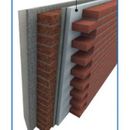Insulating Brick Walls in a Warm-Humid Climate
I’m building a rowhouse in Buenos Aires (walls abut neighbors walls on 2 sides) with brick (the standard building material here). It will have 2 rows of bricks with a gap of around 3cm. I would like to put insulation panels or spray something before the second row of bricks is put up. It is not typical to use insulation in Buenos Aires and I’m concerned about condensation. It’s a humid climate, but rarely goes below freezing.
I’m leaning towards panels of Rockwool or EPS or GPS, or possibly a spray polyurethane foam. Is it safe to say that at my small thickness of insulation I don’t have to worry about condensation problems as vapor will pass through? Do I need any vapor barriers (would have to be a coating vs a sheet) or should I just let this breathe in both directions as a brick house normally would?
I’m thinking no gap and no insulation on walls that abut the neighbors. What about bathrooms on exterior walls with porcelain tiles covering the whole wall – will I have humidity trapped between the tiles and the insulation? Thanks for any advice !
GBA Detail Library
A collection of one thousand construction details organized by climate and house part










Replies
I will give your post a bump, but you might have more luck searching local sites for this kind of information. When someone posts about double wythe brick walls here, they are usually asking questions about retrofitting insulation. (Martin covers this topic here: https://www.greenbuildingadvisor.com/article/insulating-old-brick-buildings.)
Out of curiosity, how will you construct the front and back walls? If it's the same structural brick approach, I would be more concerned with water management and keeping the bricks as dry as possible. Are you concerned about noise from the neighbors? Is that why you want to insulate the side walls?
Thanks for the reply. I'm only abutting against one neighbor and not all the floors are abutting on that side. The other 3 sides are not touching neighbors' structures. The normal type of building here is one row of the bricks with the holes in them whether abutting a neighbor or not.
It gets hot and humid in the summer here, and can get down to close to freezing but not below in winter. It just seemed foolish to me to not insulate. But I'm very nervous about being in uncharted territory - I really do not want condensation inside the walls. 3 of the walls will be bricks with holes in them on the inside, gap w/ insulation, and then normal exposed brick on the outside. The one wall facing neighbor will only have the gap/insulation on the floor that is higher than the neighbor...otherwise no gap or insulation.
Cost-wise, EPS panels are the cheapest, but facing the busy street I was thinking a water repellant Rockwool for thermal and acoustics insulation might be worth the additional cost. Another option available here is closed cell spray polyurethane, but much more expensive than the EPS panels.
The builder who has never added insulation to a brick structure, proposes an "asphalt paint" which I think is like a roofing tar type of material (to block water and vapor permeability I think), applied to the outside of the inner wall before placing the insulation in the cavity, followed by the exposed brick that will get a transparent water impermeable layer.
I hate that I'm doing something new and no no one seems too concerned with condensation.
I’d be leery of putting in anything like spray foam or EPS. Rock wool seems perfect. Sound insulation and won’t affect the vapor permeability.
Have you tried contacting the Green Building Council of Brazil or any other local or regional organizations? I suspect you will get better advice from one of those sources.
Adding an inch of foam insulation shouldn't cause any condensation issues. if the building is air conditioned, I would use foil-faced insulation to stop solar heat driven moisture from the outside. If you did that and taped the seams, the insulation would also provide your required bulk water management. Brick walls need that cavity to allow water to drain to the bottom, with weep holes and flashings to divert it to the exterior. If local custom is single wythe brick, they probably just tolerate the moisture that weeps through. The bricks don't care if they are wet or dry, but interior finishes might.
I would not apply any film-forming waterproofing material to the exterior. Those are also generally vapor barriers and they can cause some issues, though most are due to freeze/thaw cycling that sound like it's not a problem in BA. If you must apply something to the brick, use a water repellant based on silane or siloxane chemistry. Those repel bulk water but still allow vapor migration to aid drying.
Thank you everyone! Much appreciated.